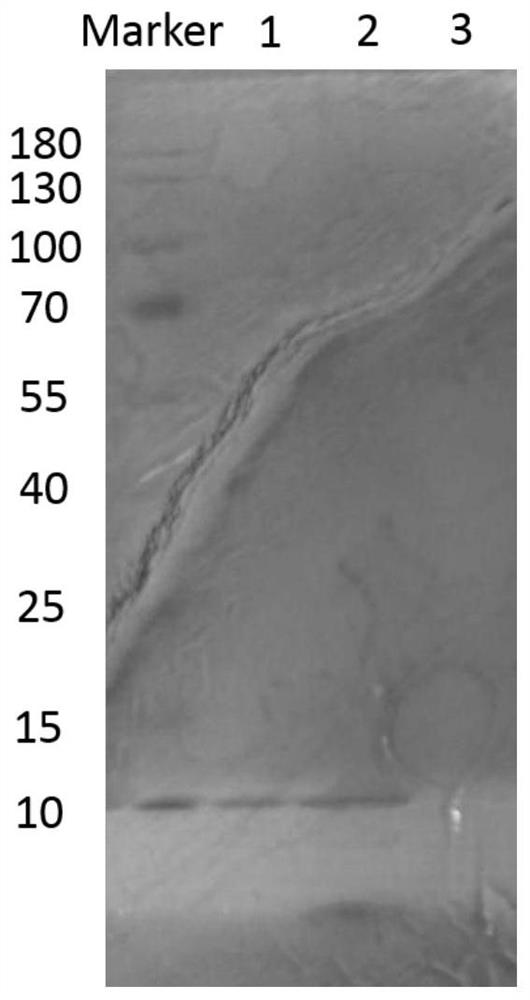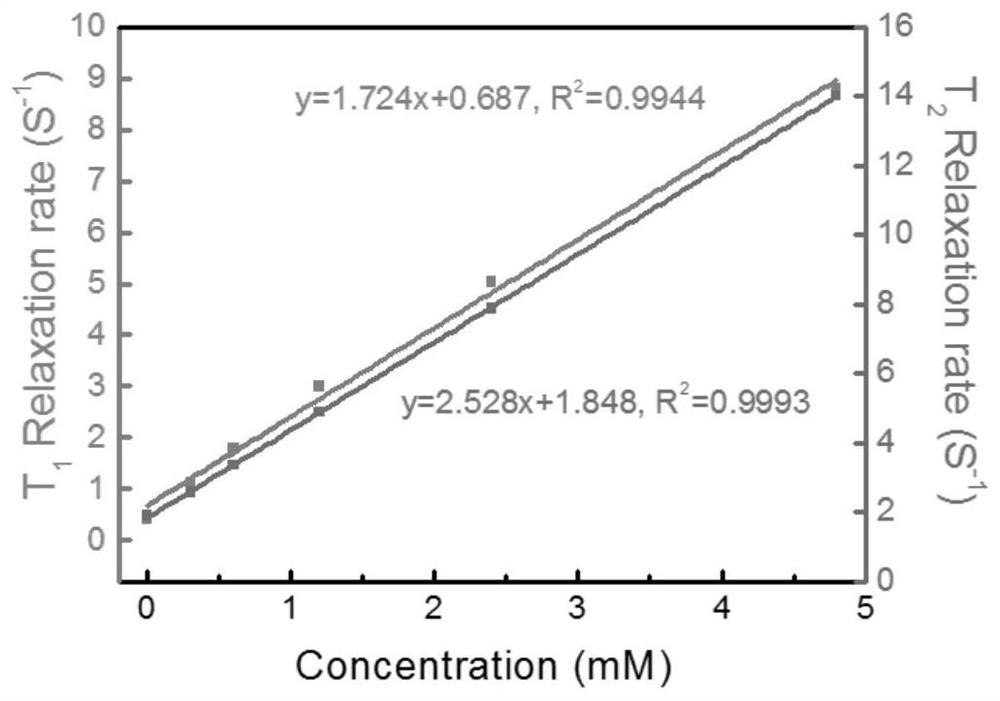A preparation method of Prussian blue nanoparticles loaded with polypeptide
A Prussian blue and nanoparticle technology, applied in the field of preparation of Prussian blue nanoparticles, can solve the problems of difficult to achieve precise treatment, lack of active targeting function, failure to accurately reach the lesion site, etc., and achieve good biological safety, Good biocompatibility and easy operation
- Summary
- Abstract
- Description
- Claims
- Application Information
AI Technical Summary
Problems solved by technology
Method used
Image
Examples
Embodiment 1
[0031] 1): Dissolve 0.02 mmol of potassium ferrocyanide and 0.5 mmol of citric acid in 20 ml of deionized water, and mix thoroughly to obtain a clear solution A; dissolve 0.02 mmol of ferric chloride and 0.5 mmol of citric acid In 20 ml of deionized water, mix thoroughly to obtain a clear solution B;
[0032] 2): Add solution A dropwise to solution B, react at 60°C to obtain aqueous solution C containing Prussian blue nanoparticles, then add 0.0006 mmoles of polyetherimide to solution C, react at 60°C for 0.5 h, the reaction system is cooled to room temperature, centrifuged and washed to obtain a precipitate D containing aminated Prussian blue nanoparticles;
[0033] 3): Dissolve the precipitate D containing aminated Prussian blue nanoparticles and 0.1 mmol of maleic anhydride in 40 ml of dimethyl sulfoxide, react at room temperature for 3 days, and centrifuge and wash to obtain carboxylated Prussian blue nanoparticles. Precipitation of particles E;
[0034] 4): Precipitate ...
Embodiment 2
[0038] 1): Dissolve 0.056 mmol of sodium ferricyanide and 1.12 mmol of citric acid in 20 milliliters of deionized water, and mix well to obtain a clear solution A; dissolve 0.056 mmol of ferrous chloride and 1.12 mmol of citric acid In 20 ml of deionized water, mix thoroughly to obtain a clear solution B;
[0039] 2): Add solution A dropwise to solution B, react at 60°C to obtain aqueous solution C containing Prussian blue nanoparticles, then add 0.001 mmol of polyetherimide to solution C, and react at 60°C After 0.5h, the reaction system was cooled to room temperature, centrifuged and washed to obtain a precipitate D containing aminated Prussian blue nanoparticles;
[0040] 3): Precipitation D containing aminated Prussian blue nanoparticles and 0.25 mmoles of succinic anhydride were dissolved in 40 ml of acetone, reacted at room temperature for 2 days, centrifuged and washed to obtain precipitate E containing carboxylated Prussian blue nanoparticles ;
[0041]4): Precipitat...
Embodiment 3
[0046] 1): Dissolve 0.04 mmol of ammonium ferrocyanide and 0.6 mmol of malic acid in 20 ml of deionized water, mix thoroughly to obtain clear solution A; dissolve 0.04 mmol of ferric chloride and 0.6 mmol of malic acid In 20 ml of deionized water, mix thoroughly to obtain a clear solution B;
[0047] 2): Add solution A dropwise to solution B, and react at 60°C to obtain aqueous solution C containing Prussian blue nanoparticles, then add 0.0008 mmol of polypropylene amine hydrochloride to solution C, and heat at 60°C The reaction was carried out for 1 hour, and the reaction system was cooled to room temperature, and centrifuged and washed to obtain a precipitate D containing aminated Prussian blue nanoparticles;
[0048] 3): Dissolve the precipitate D containing aminated Prussian blue nanoparticles and 0.16 mmol of maleic anhydride in 40 ml of dimethyl sulfoxide, react at room temperature for 3 days, and centrifuge and wash to obtain carboxylated Prussian blue nanoparticles. P...
PUM
| Property | Measurement | Unit |
|---|---|---|
| particle diameter | aaaaa | aaaaa |
| particle diameter | aaaaa | aaaaa |
| particle diameter | aaaaa | aaaaa |
Abstract
Description
Claims
Application Information
 Login to View More
Login to View More - R&D
- Intellectual Property
- Life Sciences
- Materials
- Tech Scout
- Unparalleled Data Quality
- Higher Quality Content
- 60% Fewer Hallucinations
Browse by: Latest US Patents, China's latest patents, Technical Efficacy Thesaurus, Application Domain, Technology Topic, Popular Technical Reports.
© 2025 PatSnap. All rights reserved.Legal|Privacy policy|Modern Slavery Act Transparency Statement|Sitemap|About US| Contact US: help@patsnap.com



